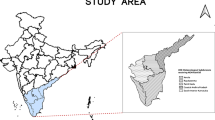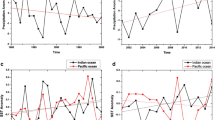Abstract
The Impact of the Indian Ocean Dipole (IOD) and the El Niño Southern Oscillation (ENSO) event for Indonesian rainfall has been investigated for the period from 1950 to 2011. Inter-annual change of IOD and ENSO indices are used to investigate their relationship with Indonesian rainfall. By using the wavelet transform method, we found a positive significant correlation between IOD and Indonesian rainfall on the time scale of nearly 2.5–4 years. Furthermore, the positive significant correlation between ENSO (sea surface temperature anomaly at Niño3.4 area indices) and Indonesian rainfall exists for shorter than 2 years and between 5.5 to 6.5-year time scales.
Similar content being viewed by others
References
Aldrian E, Susanto R D. 2003. Identification of three dominant rainfall regions within Indonesia and their relationship to sea surface temperature. International Journal of Climatology, 23(12): 1435–1452, doi: 10.1002/(ISSN)1097-0088
As-Syakur A R, Adnyana I W S, Mahendra M S, et al. 2014. Observation of spatial patterns on the rainfall response to ENSO and IOD over Indonesia using TRMM multisatellite precipitation analysis (TMPA). International Journal of Climatology, 34(15): 3825–3839, doi: https://doi.org/10.1002/joc.2014.34.issue-15
Behera S K, Yamagata T. 2003. Notes and correspondence, Influence of the Indian Ocean dipole on the southern oscillation. Journal of the Meteorological Society of Japan, 81(1): 169–177, doi: https://doi.org/10.2151/jmsj.81.169
Behera S K, Luo Jingjia, Masson S, et al. 2005. Paramount impact of the Indian Ocean Dipole on the East African short rains: A CGCM study. Journal of Climate, 18(21): 4514–4530, doi: https://doi.org/10.1175/JCLI3541.1
Behera S K, Luo Jingjia, Masson S, et al. 2006. A CGCM study on the interaction between IOD and ENSO. Journal of Climate, 19(9): 1688–1705, doi: https://doi.org/10.1175/JCLI3797.1
Black E, Slingo J, Sperber K R. 2003. An observational study of the relationship between excessively strong short rains in coastal East Africa and Indian Ocean SST. Monthly Weather Review, 131(1): 74–94, doi: 10.1175/1520-0493(2003)131<0074:AOSOTR>2.0.CO;2
Daubechies I. 1990. The wavelet transform, time-frequency localization and signal analysis. IEEE Transactions on Information Theory, 36(5): 961–1005, doi: https://doi.org/10.1109/18.57199
D’Arrigo R, Allan R, Wilson R, et al. 2008. Pacific and Indian Ocean climate signals in a tree-ring record of Java monsoon drought. International Journal of Climatology, 28(14): 1889–1901, doi: https://doi.org/10.1002/joc.v28:14
D’Arrigo R, Smerdon J E. 2008. Tropical climate influences on drought variability over Java, Indonesia. Geophysical Research Letters, 35(5): L05707
Foufoula-Georgiou E, Kumar P. 1995. Wavelets in Geophysics. San Diego: Academic Press
Farge M. 1992. Wavelet transforms and their applications to turbulence. Annual Review of Fluid Mechanics, 24: 395–458, doi: https://doi.org/10.1146/annurev.fl.24.010192.002143
Grinsted A, Moore J C, Jevrejeva S. 2004. Application of the cross wavelet transform and wavelet coherence to geophysical time series. Nonlinear Processes in Geophysics, 11(5–6): 561–566
Harou A P, Lajoie R F, Kniveton D R, et al. 2006. The influence of the Indian Ocean dipole mode on precipitation over the seychelles. International Journal of Climatology, 26(1): 45–54, doi: 10.1002/(ISSN)1097-0088
Hu Zengzhen, Nitta T. 1996. Wavelet analysis of summer rainfall over North China and India and SOI usin. 1891–1992 data. Journal of the Meteorological Society of Japan: Ser. II, 74(6): 833–844, doi: https://doi.org/10.2151/jmsj1965.74.6_833
Jevrejeva S, Moore J C, Grinsted A. 2003. Influence of the arctic oscillation and El Niño-Southern Oscillation (ENSO) on ice conditions in the Baltic Sea: The wavelet approach. Journal of Geophysical Research, 108(D21): 4677
Jiang Leishan, Li T. 2017. Why rainfall response to El Niño over Maritime Continent is weaker and non-uniform in boreal winter than in boreal summer. Climate Dynamics, 1–19, doi: https://doi.org/10.1007/s00382-017-3965-6
Kestin T A, Karoly D J, Yano J I, et al. 1998. Time–frequency variability of ENSO and stochastic simulations. Journal of Climate, 11 2258–2272
Krishnamurthy V, Kirtman B P. 2003. Variability of the Indian Ocean: Relation to monsoon and ENSO. Quarterly Journal of the Royal Meteorological Society, 129(590): 1623–1646, doi: 10.1256/qj.01.166
Nicholls N. 1984. The Southern Oscillation and Indonesian sea surface temperature. Monthly Weather Review, 112: 424–432
Qian J H. 2008. Why precipitation is mostly concentrated over islands in the maritime continent. Journal of the Atmospheric Sciences, 65: 1428–1441, doi: https://doi.org/10.1175/2007JAS2422.1
Rayner N A, Parker D E, Horton E B, et al. 2003. Global analyses of sea surface temperature, sea ice, and night marine air temperature since the late nineteenth century. Journal of Geophysical Research, 108(D14). 4407. doi: https://doi.org/10.1029/2002JD002670
Saji N H, Goswami B N, Vinayachandran P N, et al. 1999. A Dipole mode in the tropical Indian Ocean. Nature, 401(6751): 360–363
Saji N H, Yamagata T. 2003. Structure of SST and surface wind variability during Indian ocean dipole mode events: COADS observations. Journal of Climate, 16(16): 2735–2751, doi: 10.1175/15200442(2003)016<2735:SOSASW>2.0.CO;2
Schott F A, Xie Shangping, McCreary J P Jr. 2009. Indian ocean circulation and climate variability. Reviews of Geophysics, 47(1): RG1002
Setiawan, A M, Lee W S, Ree J. 2017. Spatio-temporal characteristics of Indonesian drought related to El Niño events and its predictability using the multi-model ensemble. International Journal of Climatology, 37(13): 4700–4719, doi: https://doi.org/10.1002/joc.2017.37.issue-13
Slingo J M, Annamalai H. 2000. 1997: The El Niño of the century and the response of the Indian summer monsoon. Monthly Weather Review, 128(6): 1778–1797, doi: 10.1175/1520-0493(2000)128<1778:TENOOT>2.0.CO;2
Torrence C, Compo G P. 1998. A Practical guide to wavelet analysis. Bulletin of the American Meteorological Society, 79(1): 61–78, doi: 10.1175/1520-0477(1998)079<0061:APGTWA>2.0.CO;2
Torrence C, Webster P J. 1999. Interdecadal changes in the ENSO-Monsoon system. Journal of Climate, 12(8): 2679–2690, doi: 10.1175/1520-0442(1999)012<2679:ICITEM>2.0.CO;2
Trenberth K E. 1997. The definition of El Niño. Bulletin of the American Meteorological Society, 78(12): 2771–2777, doi: 10.1175/1520.0477.1997)078<2771:TDOENO>2.0.CO;2
Yu Jinyi, Wang Xin, Yang Song, et al. 2017. The changing El Niño-southern oscillation and associated climate extremes. In: Wang S Y S, Yoon J H, Funk C C, et al. eds. Climate Extremes: Patterns and Mechanisms. Washington, DC: AGU
Acknowledgements
Our gratitude to the Marine Computation Laboratory, Faculty of Marine Sciences and Fisheries-Udayana University, Bali which supported our research in Collaboration with Yamaguchi University, Japan. Cross wavelet software was provided by A. Grinsted. We thank Kathryn Kealoha Lee of Fulbright awardees in Udayana University for editing the English.
Author information
Authors and Affiliations
Corresponding author
Rights and permissions
About this article
Cite this article
Hendrawan, I.G., Asai, K., Triwahyuni, A. et al. The interanual rainfall variability in Indonesia corresponding to El Niño Southern Oscillation and Indian Ocean Dipole. Acta Oceanol. Sin. 38, 57–66 (2019). https://doi.org/10.1007/s13131-019-1457-1
Received:
Accepted:
Published:
Issue Date:
DOI: https://doi.org/10.1007/s13131-019-1457-1




